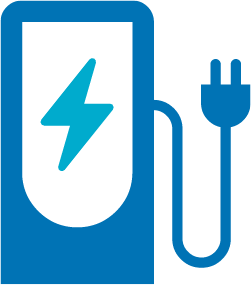Charging Infrastructure Resource Guide
A harmonized pathway to deploying road transport charging infrastructure
The transition to zero-emission vehicles (ZEVs) will require an accelerated global deployment of charging infrastructure that is well integrated into the electricity grid. This will ensure that charging infrastructure meets consumer demand and that ZEVs are an asset to the grid as a whole, reassuring users as they adopt cleaner vehicles.
Leading initiatives supporting these efforts for rapid deployment realized a coordination gap existed and resources concerning charging infrastructure rollout were decentralized. This resource guide was therefore developed as a tool for step-by-step guidance and a platform to share best practices regarding research, policy recommendations, pilot projects, and strategy development for charging infrastructure.
This resource guide:
- Provides a clear collective vision of the steps needed to enable a comprehensive charging infrastructure ecosystem appropriate for a swift transition to ZEVs
- Serves as a central resource for all stakeholders to find up-to-date research and policies regarding charging infrastructure for road transport
- Assists countries in developing and implementing their charging infrastructure strategy by providing a framework and sharing up-to-date research
- Pinpoints policy and research gaps regarding charging infrastructure

This effort was coordinated under the Breakthrough Agenda Road Transport Action 4 (RT4), which aims to bring together organizations working on charging infrastructure, and led by the ZEVTC’s secretariat, the International Council on Clean Transportation.
Deployment Features
The resources identified within this guide are arranged around three high-level features, which together facilitate a comprehensive charging infrastructure ecosystem appropriate for a swift transition to ZEVs.
Each feature is complemented by a long-term vision that will accelerate a swift transition to ZEVs and help the transport sector reach the goals of the Paris Agreement. These visions were developed by leading initiatives based on existing research.

Low carbon power availability
The availability of renewable energy is key to reach decarbonization goals through ZEV adoption.

Charger availability
Charging infrastructure needs to be widely deployed to convince all users to make the switch to ZEVs.

Positive user experience
Recharging a vehicle needs to be easy and priced fairly to reach full adoption of ZEVs.
Within each of these features, several specific enabling factors are identified to support the category’s vision. Each enabling factor should be realized in a way that promotes a more equitable, just, and sustainable ZEV transition in each market. These enabling factors may serve as focal points for collaboration through the Breakthrough Agenda’s RT4.
Enabling factors ranking system
While the resource guide offers strategies to deploy charging infrastructure for all zero-emission road transport, the specific process and relative difficulty of accomplishing each enabling factor will differ by vehicle type.
The “indicative priority” column provides a qualitative indication of how great a priority each enabling factor is for trucks and buses, passenger vehicles, and 2- and 3-wheelers, using a 1–3 scale (Dark green [1/3] means it is the first step to tackle; light green [3/3] means it is the last step to tackle).
This is regardless of the policies in place in the different regions. As an example, once a country has all the policies or actions in place for the priorities ‘1’, it can switch to the priorities ‘2’, etc.
Enabling factors are supported by a cultivated list of up-to-date resources, offering guidance and research to approach each task.
Low-carbon power availability
Vision: The power grid is prepared for EV adoption to be an asset rather than a liability, and new chargers can be easily connected to the grid.
Enabling Factor
2 and 3 wheelers
Cars and vans
Buses and trucks
Quantify, at a local level, the amount of power to be deployed, ensuring a systemic integrated approach.



3
2
1
Ensuring stakeholder coordination, clarify responsibilities, and define action items for planning, engineering, construction, and financing of the power lines (stakeholders include distributed service operators, highway operators, different levels of government, etc.), ensuring that every party has clear action items and responsibilities.
Resources:



1.5
1.5
1.5
Streamline permitting for developing new power lines, installing new transformers, and connecting EVs to the grid, maximizing common practice with other sectors with growing power demand.
Resources:



1.5
1.5
1
Ensure proactive planning is in place to avoid sunk costs and ensure sufficient electrical capacity in future years.
Resources:



2.5
1.5
1
Understand the assets EVs represent for the grid by creating an actionable plan for vehicle grid integration, including emerging solutions such as on-site energy generation and storage, smart charging, and vehicle-to-grid.
This should take into account integration with variable renewable energy and the concurrent electrification of other sectors such as heating and industry.
Resources:



2.5
1.5
1.5
Clarify business models with clear electricity rate structures (utility pricing) and transparent and predictable grid availability, and upgrades’ cost and time.
Resources:



3
1.5
1
Marginal power supply / Power to recharge vehicles comes from low-carbon energy sources
Resource:



2
2
2.5
Charger availability
Vision: Chargers are built at a sufficient pace, in the right settings, to promote a growing and dynamic market where no users are excluded.
Enabling Factor
2 and 3 wheelers
Cars and vans
Buses and trucks
Quantify how many chargers of each type/power is needed locally at different time horizons.
Resources:
- CHARIOT tool
- Phasing in U.S. Charging Infrastructure
- ICCT modeling tool EV CHARGE and HDV CHARGE
- Deploying charging infrastructure to support an accelerated transition to zero-emission vehicles, ZEVTC
- ZEVTC Charging Infrastructure Taskforce session on procurement and interoperability for HDVs
- Zero Emission Vehicle Emerging Markets Initiative (ZEV-EMI)
- National Zero-Emission Freight Corridor Strategy, U.S. Joint Office of Energy and Transportation



1.5
1.5
1
Streamline permitting for commissioning public and private charging infrastructure.
Resource:



1.5
1.5
1.5
Implement legally binding targets to ensure enough public and private charging infrastructure is developed.
Resource:



1.5
1.5
1



1.5
1
1.5
Positive user experience
Vision: Charging is a safe, easy, and dependable experience for all EV users in a mainstream market.
Enabling Factor
2 and 3 wheelers
Cars and vans
Buses and trucks
Develop sustainable financing pathways through targeted government support to ensure equity and supportive regulatory environment for private financing.
Resource:



2
2
1
Establish fair and transparent pricing system to ensure that driving with electricity is cheaper than with fossil fuels.
Resources:



2
2
2
Ensure chargers are accessible and can be used safely by all user groups (e.g., women and people with disabilities).
Resource:
- IZEVA focus area on user-friendliness (to be published Fall 2024)



1.5
1.5
1.5
Ensure data sharing and digital integration in place to ensure the deployment of an interoperable network.
Resource:



1.5
1
1.5
Implement a decision-making framework for technology choice (e.g. connector type, MCS, battery swapping, electrified road systems, etc.) to ensure the deployment of an interoperable network.
Resource:



1
1
1.5
Ensure EV users have easy access to reliable data about public charging infrastructure.
Resources coming soon



2
2
1.5
Ensure every EV user clearly understands the charging process.
Resources coming soon



2.5
2.5
2.5
Call to Action
All jurisdictions are encouraged to take part in the following initiatives to receive support for their charging infrastructure strategy development and implementation.
Zero Emission Vehicles Declaration
At COP26, hosted by Glasgow in 2021, the ZEV Declaration was launched by a leadership group of more than 100 countries, businesses, and organizations committed to driving forward a transition to a climate-neutral transportation sector. Signatories across eight categories, now numbering over 230, sign on to the global pledge to ensure that all new car and van sales be zero emission by 2040 globally, and by 2035 in leading markets.
Global Memorandum of Understanding on Zero-Emission Medium- and Heavy-Duty Vehicles
Under the Global MOU, leading countries commit to working together to enable 100% zero-emission new truck and bus sales by 2040 with an interim goal of 30% zero-emission vehicle sales by 2030, to facilitate achievement of net-zero carbon emissions by 2050.
ZEV Rapid Response Facility
Launched at COP27, the ZEV-RRF seeks to strengthen international assistance for emerging markets and developing economy countries that have signaled a high ambition towards a ZEV transition. The ZEV-RRF provides coordinated, easy, and quickly accessible short-term technical assistance by connecting countries to a global network of technical experts and delivery partners through a single-entry point.
Collaborating Partners



We thank the United Nations Economic Commission for Europe and the Electric Vehicle Initiative for their review of this guide.
